Beneficial rains have been observed across the northern U.S. Virgin Islands and Puerto Rico.
Additional improvements in drought conditions are expected through September.
View this update in Spanish.
Key Points
- Puerto Rico Conditions: Rains observed during late May and early June improved the drought conditions across Puerto Rico, cutting the areal coverage of Moderate Drought (D1) nearly in half, from 20% of the island to 8% of the island.
- U.S. Virgin Islands Conditions: The aforementioned rains improved the drought conditions across the northern U.S. Virgin Islands, with Severe Drought (D2) in May improving to Abnormally Dry (D0) conditions on St. Thomas and to Moderate Drought (D1) on St. John by the end of June. However, Severe Drought (D2) continues to be observed across St. Croix. The Rohlsen Airport location has seen only 7.81 inches of rain in 2021 through June 28, a deficit of nearly 5 inches, and the 6th driest year to date total in 62 years of data.
- Puerto Rico Impacts: Rainfall deficits decreased across most of the local islands, with soil moisture and streamflows recovering.
- U.S. Virgin Islands Impacts: Conditions vary widely from south to north, with St. Croix still in Severe Drought (D2). But recent above-normal rainfall (about 200% of normal so far in June) has improved conditions significantly in St. Thomas, where the level of water wells has improved dramatically in June (Figure 1). Sporadic rainfall territory-wide is mildly recharging ponds and collection containers. Soil moisture has increased due to sporadic rainfall, but persistent high wind speeds are likely to somewhat reduce this beneficial impact. Vegetation and trees are showing signs of improvement.
- Looking Ahead: The July/August/September outlook from the Caribbean Climate Outlook Forum (CariCOF) forecasts a small tilt towards wetter-than-normal conditions. This should result in continued drought improvement, as the wettest time of the year approaches. On the flip side, temperatures are expected to remain above normal, which will lead to increased stress on water supply and vegetation.
- For weather information specific to your area, please monitor products issued by the National Weather Service in San Juan, Puerto Rico.
U.S. Drought Monitor map for Puerto Rico, as of June 29, 2021. The U.S. Drought Monitor is updated each Thursday to show the location and intensity of drought across the country.
Nearly 19% of Puerto Rico is classified by the U.S. Drought Monitor as being Abnormally Dry (D0), while 8.3% of the island is classified as Moderate Drought (D1).
U.S. Drought Monitor map for the U.S. Virgin Islands, as of June 29, 2021. The U.S. Drought Monitor is updated each Thursday to show the location and intensity of drought across the country.
Recent above-normal rainfall (through June 28, the month to date rainfall total of 4.37 inches at Charlotte Amalie was about 200% of normal) has resulted in Saint Thomas improving to Abnormally Dry (D0) conditions. Saint John and Saint Croix remain in Moderate (D1) and Severe (D2) drought, respectively.
U.S. Drought Monitor Categories
U.S. Drought Monitor map for Puerto Rico, as of June 29, 2021. The U.S. Drought Monitor is updated each Thursday to show the location and intensity of drought across the country.
Nearly 19% of Puerto Rico is classified by the U.S. Drought Monitor as being Abnormally Dry (D0), while 8.3% of the island is classified as Moderate Drought (D1).
U.S. Drought Monitor map for the U.S. Virgin Islands, as of June 29, 2021. The U.S. Drought Monitor is updated each Thursday to show the location and intensity of drought across the country.
Recent above-normal rainfall (through June 28, the month to date rainfall total of 4.37 inches at Charlotte Amalie was about 200% of normal) has resulted in Saint Thomas improving to Abnormally Dry (D0) conditions. Saint John and Saint Croix remain in Moderate (D1) and Severe (D2) drought, respectively.
Current Conditions
Rainfall Deficits
- Puerto Rico: Year-to-date (YTD) rainfall amounts vary widely across the island, with deficits of 8 inches to 12 inches along portions of the southern coast in the municipalities of Cayey, Guayama, and Salinas, as depicted by the Moderate (D1) drought in this area by the U.S. Drought Monitor. Meanwhile, parts of the west coast and western interior have rainfall surpluses of 16 inches to 20 inches. Thanks to over 9 inches of rain so far in June, the YTD deficit at San Juan is now less than 1 inch. In terms of percent from normal rainfall, the western interior of Puerto Rico has received about 150%–200% of normal rainfall, while we are estimating between 25% and 50% of normal rainfall across portions of the southern coast.
- U.S. Virgin Islands: Year-to-date rainfall deficits for the U.S. Virgin Islands vary widely, with Cyril King Airport in Charlotte Amalie having a YTD deficit of only 1.7 inches, while Rohlsen Airport in St. Croix has a YTD deficit of nearly 5 inches. Hence, the variation in drought levels between St. Thomas (D0) and St. Croix (D2).
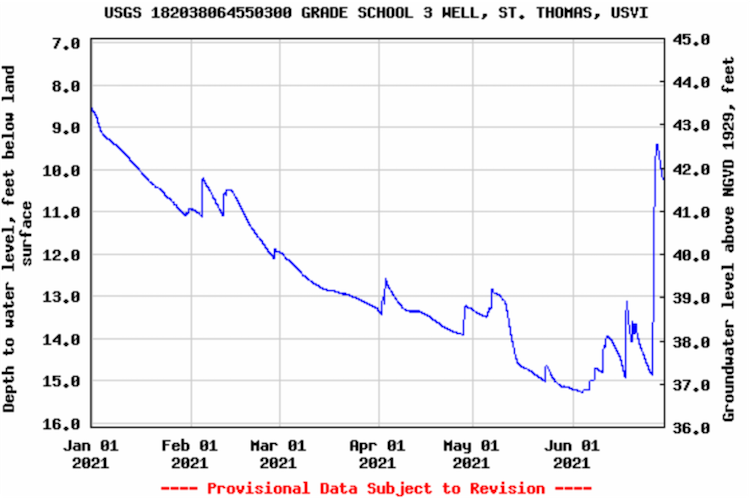
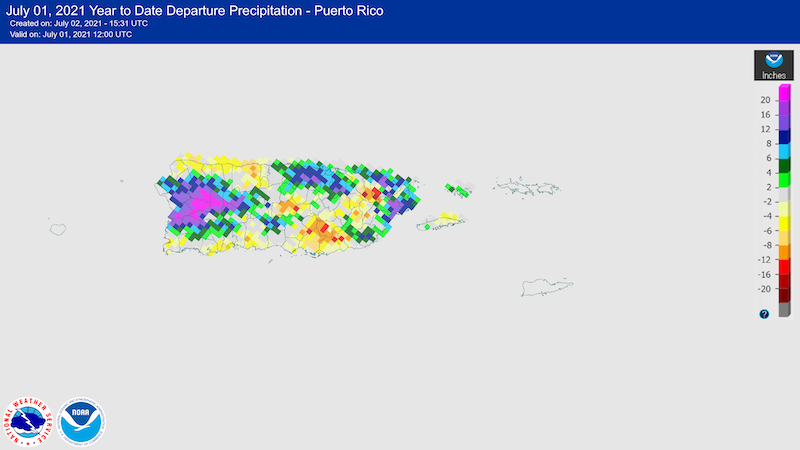
Soil Moisture Conditions in Puerto Rico
Based on data retrieved from the Puerto Rico Agricultural Water Management (PRAGWATER), dry soils continued to be observed across southern Puerto Rico, as well as a few spots across the eastern interior and northwest Puerto Rico.
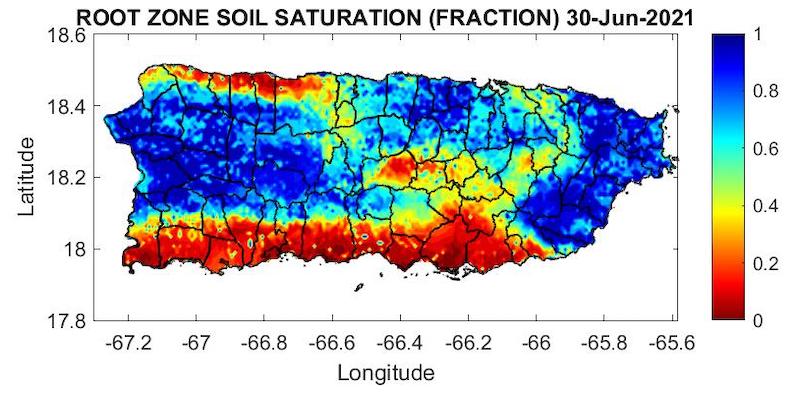
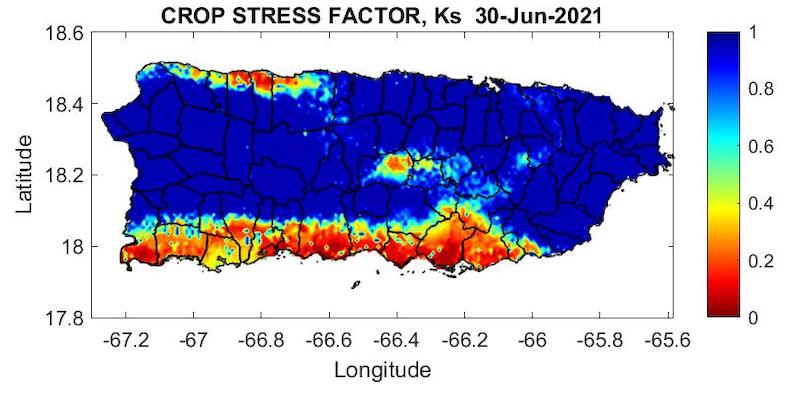
Streamflow Conditions in Puerto Rico
The 28-day average streamflow measured by the U.S. Geological Survey (USGS) gaging network shows most of the streamflows running near normal with a few spots running below normal across south and central Puerto Rico (Figure 6).
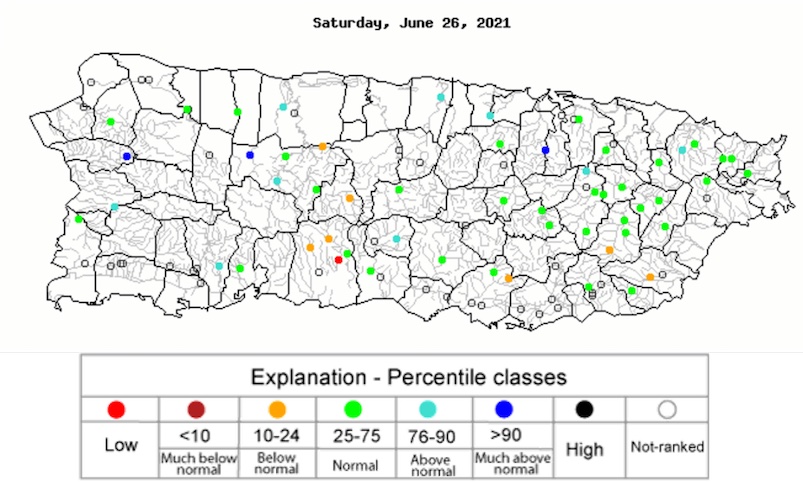
Groundwater Conditions
The groundwater level retrieved from the U.S. Geological Survey (USGS) network indicated most of the wells at normal levels except for a few outliers across south and north central Puerto Rico.
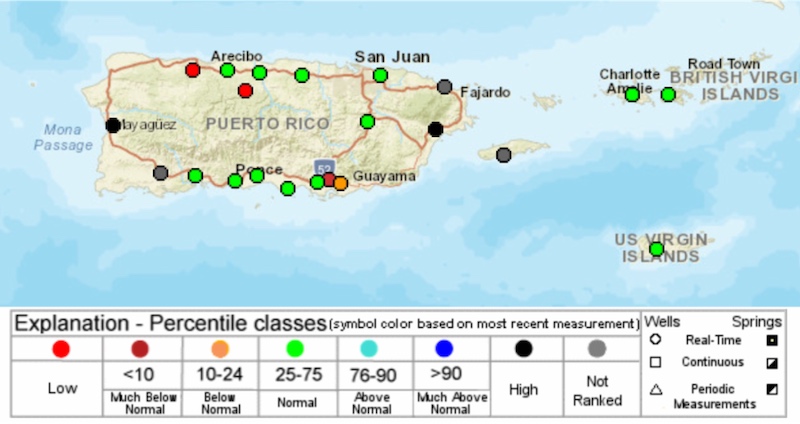
Outlooks and Impacts
Rainfall Outlook
Based on the 3-month extended forecast by the Caribbean Climate Outlook Forum (CariCOF), there are enhanced chances to observe average to above-average rainfall through September.
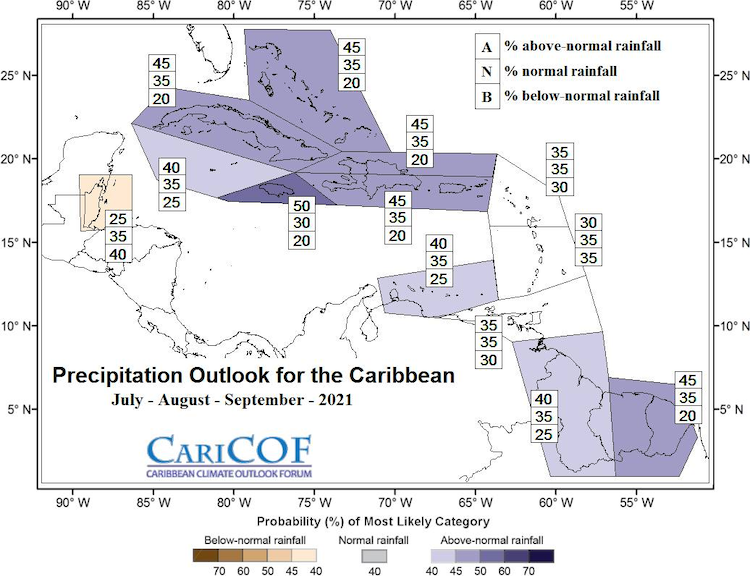
Sector Impacts
General conditions
- Puerto Rico: Recent rains over much of Puerto Rico have improved conditions for most sectors. Moderate drought conditions continue to affect non-irrigated farms in the southwestern part of the island.
- U.S. Virgin Islands: Back in May, all major islands in the USVI were experiencing a severe drought (D2 classification according to the U.S. Drought Monitor). They all received a USDA secretarial drought disaster declaration. In the past few weeks, however, drought conditions have improved due to intermittent and sporadic rain across territory. Farmers are reporting mild signs of vegetation returning from dry and brittle to green, as well as increased soil moisture. As a result, they are no longer planning mitigation efforts to feed livestock as farmers reported having enough to get through the dry season.
Forest and fire conditions
- Region-wide: Fire risk continues on dry, windy days in those areas with continued dry soils and fuels, including southwestern Puerto Rico.
Agricultural conditions
- Puerto Rico: A farmer in the southern municipality Santa Isabel reports that rain continues to be scarce in the area. The effects of drought are apparent in non-irrigated areas on the farm. Crops without plastic mulch show signs of salt accumulation.
- St. Croix, USVI: Livestock farmers on St. Croix are no longer seeking to purchase feed as chop as it is mildly available, and those seeking cut and carry to offset feed are no longer concerned about purchasing hay. Farmers reported that while some rain fell, intermittent high temperatures along with high winds are still creating an impact to soil moisture, which is creating an underlying need for additional irrigation systems in their fields. Poultry farmers are reporting increased water in cisterns which is increasing egg production that was impacted earlier due to extreme heat and drought. The Virgin Islands Department of Agriculture (VIDA) reported that on St. Croix, water deliveries to the agricultural community included more than 1,312,000 gallons in May, and in June water deliveries were listed as 976,170 gallons.
- St. John, USVI: Farmers are reporting that rain has quelled drought conditions and has had an impact so that they can collect water to regulate irrigation practices in early morning and late afternoon to maximize water resources.
- St. Thomas, USVI: Farmers are reporting intermittent and sporadic rain, and trees and vegetation are responding. Poultry farmers who have had access to little or no grass are reporting an uptick in grass and related vegetation for feed, which is increasing overall production.
For More Information
- National Weather Service (NWS) Weather Forecast Office – San Juan: Climate and Drought Information
- NWS Drought Information Statements for Puerto Rico and the U.S. Caribbean
- Drought.gov:
- Caribbean Drought Bulletins. Caribbean Regional Climate Center, Caribbean Institute for Meteorology and Hydrology (CIMH), Barbados
- U.S. Department of Agriculture (USDA) Caribbean Climate Hub drought and disaster assistance resources for tropical forestry and agriculture
Prepared By
Odalys Martinez
Senior Service Hydrologist, NWS Weather Forecast Office – San Juan
Meredith Muth
NOAA/National Integrated Drought Information System (NIDIS)
William Gould, Nora Álvarez-Berríos, and Eva Holupchinski
USDA Caribbean Climate Hub, USFS International Institute of Tropical Forestry
Christina Chanes, Gregory Guannel
University of the Virgin Islands
Victor Murphy
Climate Services Program Manager, National Weather Service Southern Region
Puerto Rico Reporting Input: Thanks to the Agricultural Extension Service, College of Agricultural Sciences, University of Puerto Rico-Mayaguez. Thanks to Betzaida Ortíz Carrión, Finca Atabey and Eric Harmsen, Professor of Agricultural Engineering UPR.
USVI Reporting Input: Several individuals contributed to this report, and we are acknowledging the following for their support, including the faculty, staff, and collaborators of the UVI School of Agriculture, Cooperative Extension, UVI Physics Program, UVI Etelman Observatory, UVI Agricultural Experiment Station, VI Department of Agriculture, UVI Caribbean Green Technology Center, as well as the USDA Office of the Chief Economist, National Parks Service in St. Croix, USDA Farm Service Agency, Coral Bay Community Council, and the many volunteers, drought reporters and farmers from across the territory.
About This Report
This drought update is issued in partnership between the National Integrated Drought Information System (NIDIS), National Oceanic and Atmospheric Administration (NOAA) National Weather Service, the U.S. Department of Agriculture (USDA), and the University of the Virgin Islands. The purpose of the update is to communicate a potential area of concern for drought expansion and/or development within Puerto Rico and the U.S. Virgin Islands based on recent conditions and the upcoming three-month forecast.
NIDIS and its partners will issue these updates every two months. Subscribe for these U.S. Caribbean drought updates here.





